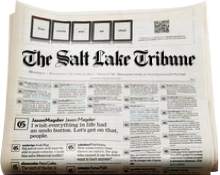This is an archived article that was published on sltrib.com in 2015, and information in the article may be outdated. It is provided only for personal research purposes and may not be reprinted.
Utah weather forecasters predict a warmer summer in western Utah and a wetter one toward the east.
The patterns follow an unusually warm March and a record-breakingly wet May.
In a climate briefing released Tuesday, National Weather Service forecaster Christine Kruse said parts of Utah have a greater than 33 percent chance of being wetter than average this summer, and other parts have the same chance of higher than normal temperatures.
"There's only so much skill in these outlooks," she said of the analysis, "so we're going to have to look and see how the pattern evolves."
Spring in Utah this year, Kruse said in the report, was "a climate roller coaster."
In March, much of Utah averaged between five and 10 degrees above normal temperatures. April temperatures were close to normal. And in May, temperatures ranged three to five degrees below normal.
Spring precipitation also didn't follow normal patterns. Most of Utah averaged 50 to 70 percent of average precipitation through the winter, but most locations averaged 150 to 300 percent of normal precipitation during the spring. Some places logged 400 percent of their normal rainfall.
Most of that rain fell in May. Logan, Cedar City and Bryce Canyon all reported their second-wettest May on record. For Salt Lake City, it was the sixth-wettest May on record. And May's precipitation total is in the top 1 percent of months since records started being kept in 1874.
"Now the question on everyone's mind [is], what's the outlook for summer?," Kruse wrote in the briefing.
NWS' Climate Prediction Center shows the western half of the state falling into a region of the country with warmer temperatures. The eastern half falls into a zone with wetter weather forecasted.

